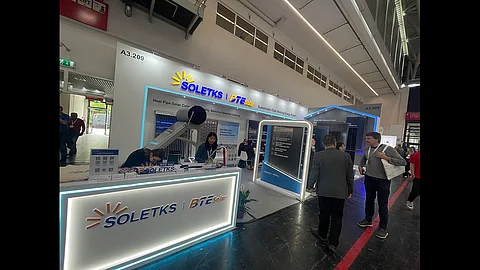

BTE Solar showcased its latest PV/T E series hybrid solar panel during the event
This product features a 580 W TOPCon module on the top layer
Using glycol as a heat transfer liquid, the module’s underlying heat chamber can produce up to 1,180 W of heat energy
Alongside the broad spectrum of conventional PV products, Intersolar Europe 2025 also featured a few companies that exhibited niche application products, like photovoltaic thermal (PVT) solutions. Among them, BTE Solar, a Chinese solar hot water system manufacturer, showcased its PV/T E series hybrid solar panel. This system can simultaneously generate electricity and recover waste heat.
The hybrid solar solution of integrates PV and thermal energy generation into a single module. It is designed with a top layer of conventional PV panel, while a thermal collector is embedded beneath it. The underlying thermal collector captures the excess heat generated by the panel during power generation, which would otherwise be wasted. This thermal collector generally features a closed-loop, copper-based piping system, integrated with an aluminum or copper metal plate. Filled with a circulating heat transfer fluid, typically glycol, the copper pipes absorb the heat from the underlying metal plate. This recovered heat is utilized for multiple applications, such as heat pump, space heating, or industrial thermal processes.
According to the datasheet, the displayed PVT module has dimensions of 2,279 × 1,134 × 37 mm and weighs 39 kg. The characteristics of this module can be categorized into electrical and thermal performance parameters.
Electrical Performance
Equipped with 144 pieces of TOPCon half-cells, the module boasts a power output of up to 580 W and an efficiency of up to 22.44%. This module is laminated with a 2,273 × 1,128 mm-sized front glass. Rated for a maximum short-circuit current of 14.31 A, it has an operating temperature range of between -40°C and +85°C.
Thermal Performance
According to the datasheet, the thermal chamber, filled with 1.2 liters of propylene glycol-based heat transfer liquid, can produce up to 1,180 W of heat. The propylene glycol liquid has a low freezing point, which prevents the fluid from freezing in cold climates. The standard working pressure for the circulation of the liquid is 0.6 MPa or 6 bar.
